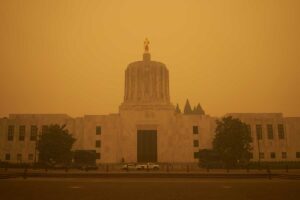Oregon OSHA launches new, free resources to help employers understand and comply with rule protecting workers against wildfire smoke

The following free resources are now available online:
- Wildfire smoke online course: Designed to satisfy certain training requirements found in the wildfire smoke rule, the course addresses such topics as air quality measurements, health effects and symptoms, the proper use of filtering facepiece respirators, and other safety measures.
- Fact sheet about the key requirements of the wildfire smoke rule: This six-page document highlights the rule’s key overall requirements, offering a reader-friendly summary of what employers and workers need to know about the rule.
Oregon OSHA adopted wildfire smoke and heat rules in May. Both rules encompass initial protective measures for workers who rely on employer-provided housing, including as part of farm operations. The heat rule took effect June 15. Resources to help understand and comply with the heat rule are available, including the recently released sample plan for the heat illness prevention plan and sample plans for rest breaks and acclimatization.
Both rules were proposed in February, following a development process that included worker and community stakeholder listening sessions, input and review by rule advisory committees, and input from employer and labor stakeholders. The rules build on temporary emergency requirements that were adopted in summer 2021 following several months of stakeholder and community engagement.
The wildfire smoke rule addresses an array of exposure assessments and controls, and training and communication measures. The heat rule requires access to shade and cool water, preventive cool-down breaks, and prevention plans and training.
More resources are available:
- A worker’s right to a safe and healthy workplace.
- Free Oregon OSHA consultations for employers to improve workplace safety and health programs – no fault, no citations, no penalties.
- Questions about how to apply rules to your workplace? Contact Oregon OSHA specialists.
- A-to-Z topic index, including updated pages for wildfire smoke and heat illness prevention.
- Oregon Department of Consumer and Business Services (includes Oregon OSHA as a division) Multicultural Communications Program, providing outreach to communities with limited English proficiency. Toll-free number: 800-843-8086.
- Ombuds Office for Oregon Workers for help understanding workplace safety and health rights, and workers’ compensation rights. Toll-free number: 800-927-1271